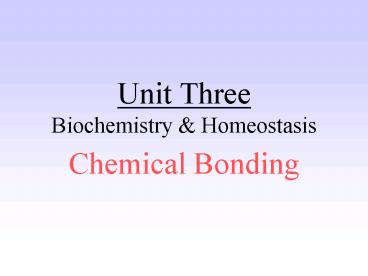Unit Three Biochemistry - PowerPoint PPT Presentation
1 / 24
Title:
Unit Three Biochemistry
Description:
... elements, compounds, molecules and diatomic molecules. Covalent Bonds cont... When atoms form diatomic molecules we will see single, double, & triple covalent ... – PowerPoint PPT presentation
Number of Views:32
Avg rating:3.0/5.0
Title: Unit Three Biochemistry
1
Unit ThreeBiochemistry HomeostasisChemical
Bonding
2
I. Bonds are the forces that hold atoms together
- We are going to learn about intramolecular forces
forces within molecules - Intramolecular forces include
- covalent bonds
- ionic bonds
- metallic bonds
3
2 Types of Bonds
- A covalent bond is formed when two atoms share
electrons to become a stable molecule/compound - An ionic bond is formed when ions are attracted
by their opposite charges and transfer electrons
4
Bonds continued
- In both cases, the atoms ultimate goal is to have
a stable e- configuration - Atoms are considered stable if they follow the
Octet Rule - ? atom must have 8 valence e- to be stable
- Exceptions ? H and He only need 2 valence e- to
be stable
5
Valence Electrons
- What are valence electrons?
- Valence electrons are the electrons in the last
shell or energy level of an atom - A quick way to determine the of valence
electrons is to look at which group the atom is
in
6
Valence Electrons
- Elements in group 1 have 1 valence electron.
- Elements in group 2 have 2 valence electrons.
- Can you guess how many valence electrons elements
in group 6 have? - If you guessed 6 valence electrons, then you are
correct!
7
Valence electrons
- Look at your periodic tables
- The Nitrogen atom has 5 valence electrons
- Why?
- What group is Nitrogen in?
- Group 15
8
Valence Electrons
- The Oxygen atom has 6 valence electrons
- Why?
- What group is Oxygen in?
- Group 16
- Do you see the pattern?
9
Electron Orbitals (Energy Levels)
- These pictures show the electron orbitals of
Nitrogen and Oxygen - 1st orbital 2 electrons max
- 2nd orbital 8 electrons max
10
Pop QuizAre Nitrogen and Oxygen stable?
- No!
- Why not?
- They do not follow the Octet Rule
11
Pop QuizWhat is the Octet Rule?
- The Octet Rule states that atoms must have 8
valence electrons to be stable ? except for H and
He.
12
II. Ionic Bonds
- Atoms that lose/gain electrons become ions
- ? charged particles
- Bonds form when ions are attracted to each other
by their () and (-) charges - A valence electron from one atom is transferred
to another atom
13
More on Ionic bondsMetals vs. Nonmetals
- METALS
- Lose electrons
- Become positive ions
- Sodium ion Na 1
- NONMETALS
- Gain electrons
- Become negative ions
- Chlorine ion Cl -1
How do you know which elements are metals and
nonmetals?
14
Metals vs. Nonmetals
- The ladder divides the metals from nonmetals
15
III. Covalent Bonds
- Strong attractions that hold nonmetallic elements
together Ex. HCl, CO2 - Associated with a great variety of materials
- found within elements, compounds, molecules and
diatomic molecules
16
Covalent Bonds cont
- Diatomic molecules are formed when 2 of the same
atoms combine - Ex. O2, H2, F2
- Both atoms have an equal attraction to the shared
electrons - Co means to share, think of other co words
17
Covalent Bonds cont
- The shared electrons count for both atoms
- Single covalent bonds share 2 e-
- Double covalent share 2 pairs of e- 4
- Triple covalent share 3 pairs of e- 6
- Count all bonds to determine if the octet rule is
satisfied or not
18
IV. Lewis Diagrams
- A Lewis Diagram consists of the element symbol
surrounded by "dots" to represent the valence
electrons. - It is also used to model the transferring/sharing
of electrons during bond formation
19
Lewis Diagrams
- Draw the following diagrams in your notes
- Which group is each element in?
20
Lewis Diagrams
- The electron dot diagram for O shows two unpaired
electrons, so it has two electrons available for
standard covalent bonds.
21
Lewis diagrams
- Lewis diagrams can show how atoms combine
- When atoms form diatomic molecules we will see
single, double, triple covalent bonds - Single covalent bonds (share 2 e-)
- H2 ? HH single covalent bond
- A dash between two atoms is sometimes
- used to show single bonds ? H-H
22
More Lewis diagrams of compounds
- Single covalent bonds continued
- Halogens (group 17 atoms) also share 2 e-and form
single covalent bonds - Cl Cl
- Count the electrons does each atom have a
complete octet?
23
More Lewis diagrams of compounds
- Double covalent bonds (share 2 e- pairs)
- Ex. O O
- Count the electrons does each atom have a
complete octet? - Triple covalent bonds (share 3 e- pairs)
- Ex. N N
24
Lewis diagrams of compoundsFinal Thoughts
- The Octet Rule and Lewis diagrams
- When drawing diagrams of compounds remember the
Octet Rule ? each atom must have 8 valence e- to
be stable - Exceptions ? H and He only need 2 valence e- to
be stable































